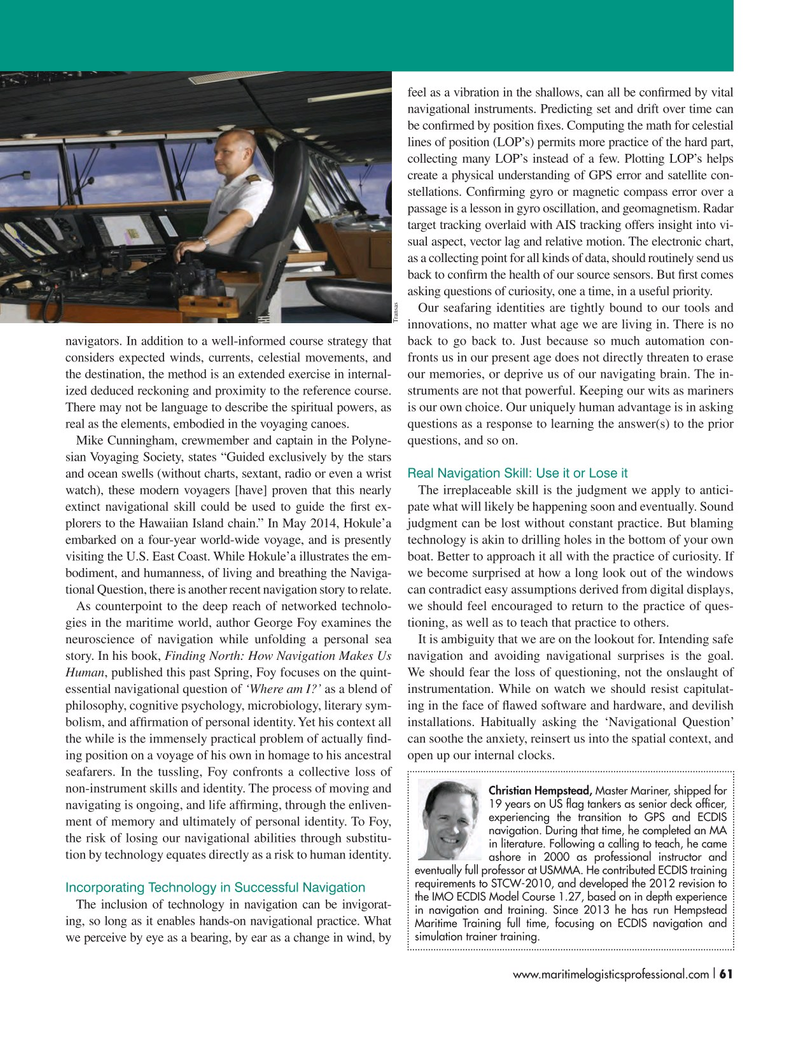
Page 61: of Maritime Logistics Professional Magazine (Q3 2016)
Shipbuilding, Repair & Maintenance
Read this page in Pdf, Flash or Html5 edition of Q3 2016 Maritime Logistics Professional Magazine
feel as a vibration in the shallows, can all be con? rmed by vital navigational instruments. Predicting set and drift over time can be con? rmed by position ? xes. Computing the math for celestial lines of position (LOP’s) permits more practice of the hard part, collecting many LOP’s instead of a few. Plotting LOP’s helps create a physical understanding of GPS error and satellite con- stellations. Con? rming gyro or magnetic compass error over a passage is a lesson in gyro oscillation, and geomagnetism. Radar target tracking overlaid with AIS tracking offers insight into vi- sual aspect, vector lag and relative motion. The electronic chart, as a collecting point for all kinds of data, should routinely send us back to con? rm the health of our source sensors. But ? rst comes asking questions of curiosity, one a time, in a useful priority.
Our seafaring identities are tightly bound to our tools and
Transas innovations, no matter what age we are living in. There is no navigators. In addition to a well-informed course strategy that back to go back to. Just because so much automation con- considers expected winds, currents, celestial movements, and fronts us in our present age does not directly threaten to erase the destination, the method is an extended exercise in internal- our memories, or deprive us of our navigating brain. The in- ized deduced reckoning and proximity to the reference course. struments are not that powerful. Keeping our wits as mariners
There may not be language to describe the spiritual powers, as is our own choice. Our uniquely human advantage is in asking real as the elements, embodied in the voyaging canoes. questions as a response to learning the answer(s) to the prior
Mike Cunningham, crewmember and captain in the Polyne- questions, and so on. sian Voyaging Society, states “Guided exclusively by the stars and ocean swells (without charts, sextant, radio or even a wrist Real Navigation Skill: Use it or Lose it watch), these modern voyagers [have] proven that this nearly The irreplaceable skill is the judgment we apply to antici- extinct navigational skill could be used to guide the ? rst ex- pate what will likely be happening soon and eventually. Sound plorers to the Hawaiian Island chain.” In May 2014, Hokule’a judgment can be lost without constant practice. But blaming embarked on a four-year world-wide voyage, and is presently technology is akin to drilling holes in the bottom of your own visiting the U.S. East Coast. While Hokule’a illustrates the em- boat. Better to approach it all with the practice of curiosity. If bodiment, and humanness, of living and breathing the Naviga- we become surprised at how a long look out of the windows tional Question, there is another recent navigation story to relate. can contradict easy assumptions derived from digital displays,
As counterpoint to the deep reach of networked technolo- we should feel encouraged to return to the practice of ques- gies in the maritime world, author George Foy examines the tioning, as well as to teach that practice to others. neuroscience of navigation while unfolding a personal sea It is ambiguity that we are on the lookout for. Intending safe story. In his book, Finding North: How Navigation Makes Us navigation and avoiding navigational surprises is the goal.
Human, published this past Spring, Foy focuses on the quint- We should fear the loss of questioning, not the onslaught of essential navigational question of ‘Where am I?’ as a blend of instrumentation. While on watch we should resist capitulat- philosophy, cognitive psychology, microbiology, literary sym- ing in the face of ? awed software and hardware, and devilish bolism, and af? rmation of personal identity. Yet his context all installations. Habitually asking the ‘Navigational Question’ the while is the immensely practical problem of actually ? nd- can soothe the anxiety, reinsert us into the spatial context, and ing position on a voyage of his own in homage to his ancestral open up our internal clocks. seafarers. In the tussling, Foy confronts a collective loss of non-instrument skills and identity. The process of moving and
Christian Hempstead, Master Mariner, shipped for 19 years on US ? ag tankers as senior deck of? cer, navigating is ongoing, and life af? rming, through the enliven- experiencing the transition to GPS and ECDIS ment of memory and ultimately of personal identity. To Foy, navigation. During that time, he completed an MA the risk of losing our navigational abilities through substitu- in literature. Following a calling to teach, he came tion by technology equates directly as a risk to human identity. ashore in 2000 as professional instructor and eventually full professor at USMMA. He contributed ECDIS training requirements to STCW-2010, and developed the 2012 revision to
Incorporating Technology in Successful Navigation the IMO ECDIS Model Course 1.27, based on in depth experience
The inclusion of technology in navigation can be invigorat- in navigation and training. Since 2013 he has run Hempstead ing, so long as it enables hands-on navigational practice. What
Maritime Training full time, focusing on ECDIS navigation and simulation trainer training.
we perceive by eye as a bearing, by ear as a change in wind, by www.maritimelogisticsprofessional.com 61I 50-63 Q3 MP2016.indd 61 8/17/2016 10:29:44 AM

 60
60

 62
62
